|
Lorax Forest Care takes a gentler
approach to logging
written by Ole Bye
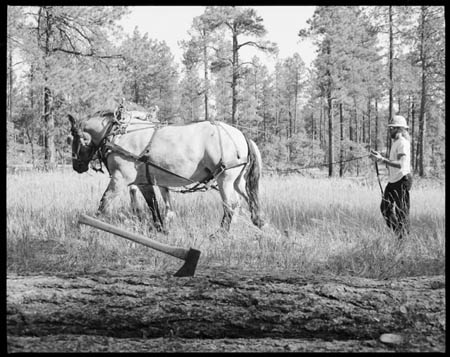 |
| Chris Vandeleur drives
his draft horses Fanny and Dan past a log deck on
the Timberdale Ranch subdivision near Bayfield. The
Belgian- Percheron crosses are brother and sister
and weigh 2,000 pounds each./Photo by Ole Bye |
Care is not a sentiment typically associated
with logging. But the employees of Lorax Forest Care seem
to genuinely care about their work, and it shows in all
facets of the operation, from the marking of fated trees
to the final sawmill cuts. But the great embodiment of
this care is in the draft horses used to drag felled trees
out of the woods. Horses are the environmentally sensitive
backbone for a modern philosophy of logging practiced
by Lorax owner Eric Husted and his crew. Husted’s
hope is “to try and change people’s perceptions
from logging to forest restoration, to look at it as a
service that’s going to enhance the value of their
property, rather than a way to make money off the land.”
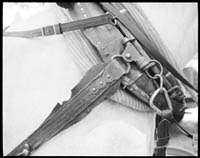 |
| A detail of a part of
the harness called the collar, which bears the weight
of the horse’s pull./Photo by Ole Bye |
The relatively minor impact left by Lorax and its horses
leads employee Chris Vandeleur to echo these sentiments:
“We’re not just working and making a buck
85 we’re making a little bit of the whole better.”
The Bayfield-based crew thins forests on private land
with the main purpose of protecting rural homes from wildfire.
But fire mitigation isn’t the only consideration
people make when hiring Lorax. Many are combining fire-fuels
reduction with a desire to maintain forest health. Residents
of Timberdale Ranch, near Bayfield where Lorax is now
at work, decided that low-impact logging was the right
path to good forest stewardship. Resident Doug Maxwell
says, “Initially my concern was the fire danger.
And the bonus is that we get to restore the forest to
a healthy, natural condition.”
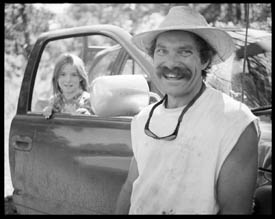 |
| Lorax owner Eric Husted and daughter
Kyla./Photo by Ole Bye |
The work
On a typical day, one might not even notice the Lorax
crew at work. Only the distant whine of chainsaws betrays
the intense labor of Lorax employees Luis Ramos and Luis
Arellanes. The pair is usually well ahead of the horses,
felling trees on distant properties while the team follows
behind, bringing logs to the roadside.
Felling trees is far from easy. Ramos and Arellanes first
evaluate marked trees and predict where they can be dropped
to benefit the horses. Brush must then be cleared from
around their bases, and any snags that might impede the
fall must be removed. Eventually, the tree is cut and
all of its branches are removed. This “slash”
is piled to one side leaving a clear path for the horses
to remove the log.
Although men are doing some of the hardest work, the
horses remain the stars. Husted concedes, “(People)
come and all they want to do is take pictures of the horses.”
Coming upon the team working in the woods feels a bit
magical, as if one is looking into another age. From a
distance, the horses seem to move smoothly and naturally
through the woods. But up close, the ground shakes as
they pound past, hot breath rasping through dilated nostrils,
with Chris Vandeleur in tow.
Vandeleur pauses tensely in the otherwise constant motion
of his work, a leather rein held firmly in each hand.
At his fingertips are the combined 4,000 pounds of Dan
and Fanny, brother and sister Belgian-Percheron crosses.
The horses shift and stomp, eager to pull, despite the
heat and dust. Their heavy leather harnesses creak and
sing with a metallic jangle. “Wait for me,”
Vandeleur warns crossly as Fanny shows signs of jumping
the gun. Then he says in an even, conversational tone,
“OK, let’s walk.”
The team explodes into motion, nearly cantering as they
thunder out of the stand of ponderosas with a 30-foot
log in tow. Vandeleur careens after them, hopping back
and forth across the skidding, bouncing log, attempting
to keep slack reins while not being crushed. In a few
seconds they reach the edge of a field and pull alongside
other logs in a “deck” formation, where Vandeleur
halts to unfasten the log chain. Then all three return
to the woods to repeat the process.
Fanny and Dan seem to enjoy the logging, and so does
Vandeleur. He says of the work, “It might be the
best I’ve ever done. (It) keeps me in shape for
hunting season.”
That’s no wonder, considering the miles he runs
following his charges. An apparent vein of fun runs through
the work, along with a vein of concern. Husted says that
he wouldn’t be in logging without the horses. “Yeah,”
he replied. ”They’re the main incentive. They’re
the best part!”
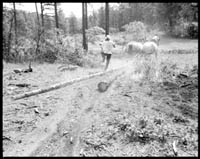 |
Vandeleur leaps across
two tumbling
logs as he races to keep up with the
team./Photo by Ole Bye |
Getting down to business
Being fun and eco-friendly are not the only traits that
make the horses valuable to Lorax. They also keep Husted
from having to advertise. “They sell themselves,”
he says. “A lot of the people who hire us, hire
us just because the horses are involved.” The premise
works well. Husted is booked for the next two years and
has increased his work force from just a couple employees
to six. He has four horses to choose from when making
up teams and is raising a fifth.
A fairly new addition to the business has been a small,
mobile sawmill, operated by two people, which is used
to cut rough lumber. In the future, Husted plans to open
a woodworking shop as a further extension of the process.
But he’s cautious about capitalizing on his easy
source of timber: “I don’t buy any of the
material unless I’ve already got it sold,”
he says. “All that stuff we’re milling down
there is from pre-existing orders. The standard logging
thing where you buy standing trees and cut them down and
try and make money is just bad forestry. Because really
the only way you can make money is if you go in and take
the nicest biggest trees and get out as fast as possible,
with no mitigation.”
Lorax’s profits come mostly from the fees landowners
pay to have their forests managed. Husted says that selling
logs doesn’t pay the bills when using horses. “I
tried that for the first year and a half,” he says.
“If you do really high volume and work 80-hour weeks,
you might be able to make a living that way, but it would
be hard.”
Still, Lorax’s niche is a valuable one, according
to Husted. People are willing to pay more for a better,
more environmentally sound job. And people also are willing
to pay for the ideals espoused by the company.
“We’d be better off doing more things with
a lighter hand than always bringing in big guns, big technology,
big power,” Husted says. “You can accomplish
the same things with a much lighter touch.”
Lighter touch also makes for smaller overhead. “I
started with two horses for about 3,000 bucks, and a chain
saw, and a trailer and a truck,” Husted says. “So
you can get into business way cheaper with horses than
you can with heavy equipment.”
One paradox of the Lorax operation, however, is the use
of an outside contractor’s mulching tractor to chop
up ladder fuels after the horses have removed the logs.
The result is a low-fuel, nutrient-rich forest floor,
which is ready to sprout grass. Except for the mulch,
you might not know a tractor had been in the woods, because
if there is impact, it isn’t visible.
“We don’t really need giant bulldozers and
stuff for most of this work. But then I’m not opposed
to... (the) chipping unit. It does exactly what we want.
It lays stuff down on the ground and makes it fire safe,”
says Husted.
As for the future, Husted is optimistic. At a pace of
1 to 2 acres a day, he has work in his current location
for months to come. “There are thousands of acres
that could use the same thing that we’re doing,”
he reports. “We’re supporting about five families
on three, 400 acres of timber a year. So you could support
dozens of little operations like this around here, and
people would make good money, and they’d get to
stay close to home.”
Making the Lorax choice
Although homeowners in the Four Corners area were marginally
interested in thinning trees on their property before
the summer of 2002, “There was a catalyzing event,
and it was called the Missionary Ridge Fire,” says
Joni Hedemark, a resident of Timberdale Ranch. Hedemark
was largely responsible for initiating the process
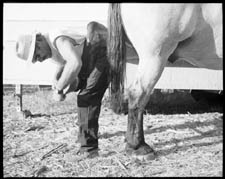 |
| Husted trims and files
Dan’s unshod hooves, which keeps them from chipping
or breaking./Photo by Ole Bye |
that led to hiring Lorax to do work at Timberdale Ranch.
When Hedemark learned of cost-share grants available from
the State of Colorado to aid in wildfire mitigation, she
tossed the idea to the Homeowners Association, and 80
percent of residents indicated they were willing to participate.
Homeowners began to educate themselves on what needed
to be done to protect their homes from fire. They brought
in Husted, who lives nearby, to give talks on forest management,
and a partnership was born.
But it wasn’t just neighborly goodwill that led
Timberdale Ranch to hire Lorax. Residents also admired
Husted’s ideals and methods. “Many of us liked
his approach to forest management – more of a common-sense
approach, if you will; nonaggressive and perhaps not typical
of what we would picture to be a logging approach,”
Hedemark says. And, of course, there’s the horses:
“We also liked that he utilized the horses, a tool
that was so common at the turn of the century.”
When thinning is completed to correct standards, Timberdale
residents will receive a $93,000 grant from the state.
To date, all properties in Timberdale that have been thinned
have passed inspection even though the Colorado State
Forest Service offers no incentive to encourage environmentally
sound logging practices.
Husted says that horses seem to be an ideal, if not sanctioned,
tool for thinning forests on private property around houses.
“I see the horses as an excellent tool for doing
just exactly what we’re doing – thinning in
areas that are populated and already roaded,” he
says.
The team can work in tighter spots, for example, around
houses than big machines can. Also, less impact appeals
to homeowners like Hedemark, who notes, “If (Eric)
were to skid logs on your property, depending on the situation,
in three to four weeks the skid trails are gone.”
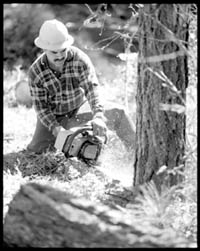 |
| Luis Arellanes fells a tree./Photo
by Ole Bye |
Healing the forest
After Husted and crew pass through a forest, its face
is changed dramatically. Trees stand well apart from each
other, the forest floor is shorn of ladder fuels like
scrub oak, and sunlight fills the woods. Initially, it
looks too manicured to be natural, but Husted comments,
“That’s a little closer to the original components
of the ecosystem – bigger ponderosas and more grass.”
Fewer trees are now competing for water in the thinned
area, so they have a better chance of being healthier
and disease-resistant. “When trees start to get
bigger and closer together, and you throw in a drought,
the competition becomes even more keen,” says Kent
Grant of the Colorado State Forest Service.
Moving onto the next area of Timberdale to be thinned,
Husted marks trees to be cut and explains what he’s
looking for in the trees he’s cutting. “We’re
thinning for 15- to 30-foot spacing,” he says. “We’re
removing anything that looks unhealthy or weak.”
And then indicating a large ponderosa, he says, “Wow,
that’s a cool tree.”
Walking on, he suggests that the forest can be restored
to its natural, original state. “It’ll take
a hundred years, I’m sure. But yeah, I think it’s
doable,” he asserts, spraying another blue “x.”
A quarter mile below, the horses are working, but they
can’t be seen or heard.
|

